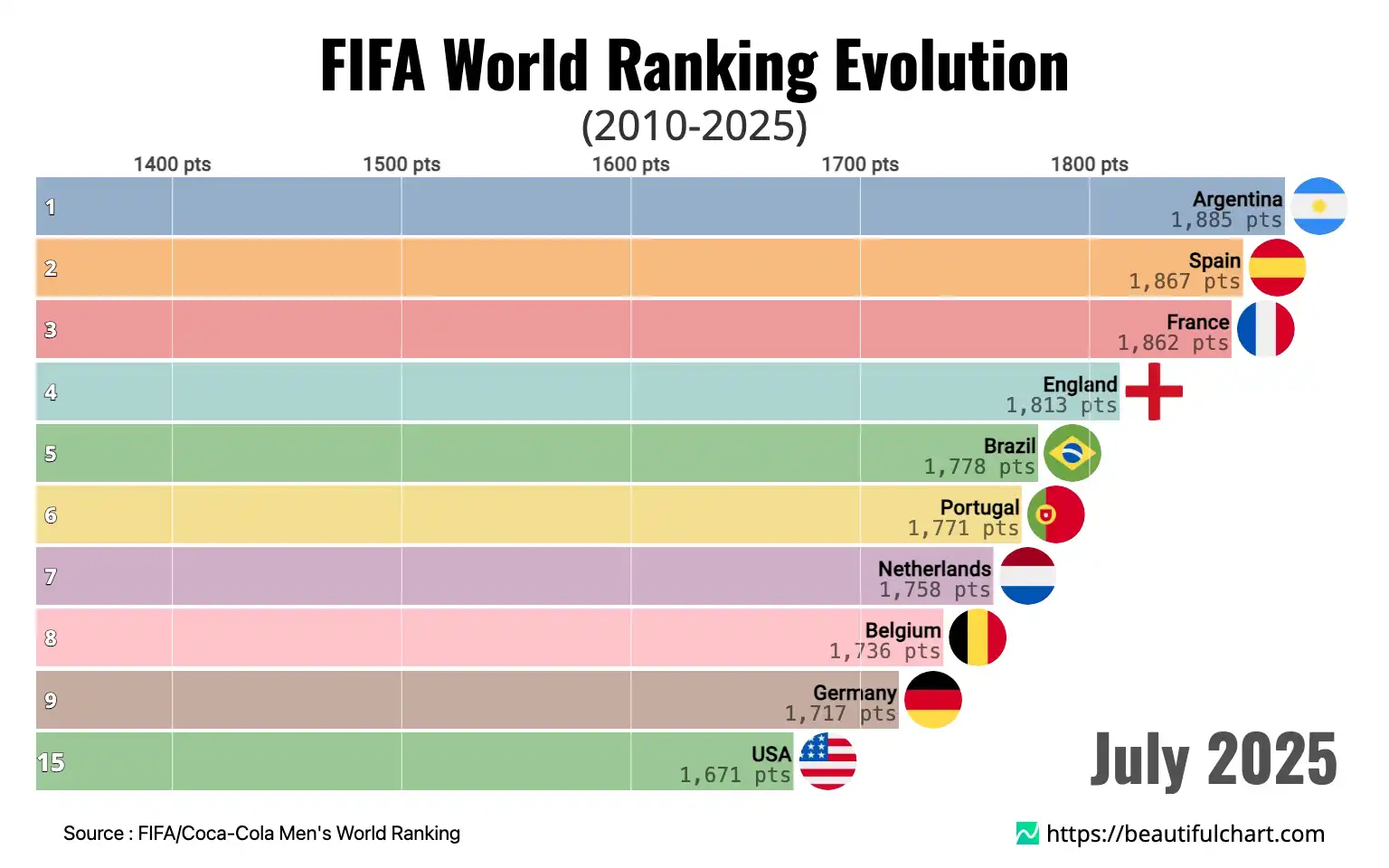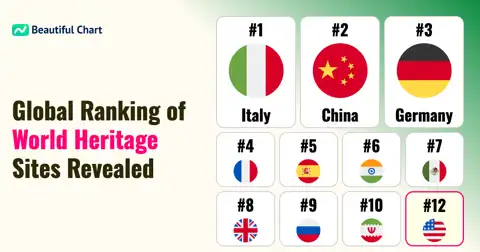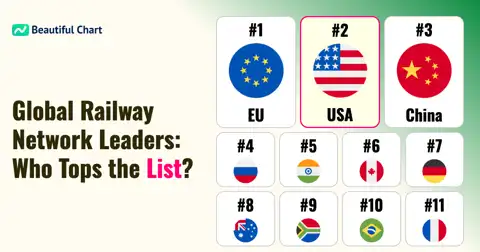The latest FIFA world rankings highlight Argentina's continued dominance, holding the #1 position with 1885.4 points. European powerhouses Spain and France are in close pursuit, securing the second and third spots, respectively. The data also underscores the consistent strength of England and Brazil, both firmly positioned within the top five, while the United States solidifies its place among the world's elite at 15th.

The FIFA World Ranking is a points-based system used to rank men's national football teams. Points are awarded based on the results of all FIFA-recognized full international matches, with more points given for wins in major competitions like the World Cup. The system helps gauge the relative strength and competitive standing of teams globally.
An examination of national team performance from 2010 to 2025 reveals a dynamic and ever-shifting landscape in international football. The period showcases the sustained dominance of a few elite nations while also highlighting the rise and fall of others, reflecting the cyclical nature of talent, strategy, and international success.
The Enduring Rivalry: Europe vs. South America
Throughout the past decade and a half, the pinnacle of the rankings has been a battleground primarily for teams from UEFA and CONMEBOL. Spain's 'golden generation' saw them dominate the early 2010s, followed by Germany's ascent, which culminated in their 2014 World Cup victory. In recent years, France, with its deep talent pool, and Argentina, led by a new generation of stars, have vied for the top position. The latest standings reaffirm this trend, with Argentina, Spain, and France occupying the top three spots. This ongoing struggle for supremacy underscores the historical and contemporary strength of these two confederations, which continue to produce the majority of the world's top-ranked teams. Brazil and England remain perennial contenders, consistently featuring in the top tier, a testament to their rich footballing history and robust domestic leagues that cultivate world-class talent.
The Rise of New Contenders and Shifting Hierarchies
While traditional powers remain strong, the period has also been marked by the emergence of other formidable teams. Belgium's 'Golden Generation' saw the nation rise to the #1 ranking in 2015 and again in 2018, a remarkable achievement that challenged the established order. Similarly, Croatia's journey to the 2018 World Cup final cemented its status as a top-tier nation, and it has remained in or near the top 10 ever since. Portugal, powered by a mix of veteran icons and exciting new talent, has also become a consistent fixture in the top 10. These developments indicate that the gap between the traditional elite and other ambitious nations is narrowing, leading to a more competitive and unpredictable international scene.
The United States' Growing Presence
The trajectory of the United States Men's National Team (USMNT) over this period is one of notable growth and increasing consistency. After a period of fluctuation, which saw them ranked as high as 13th in 2014 and as low as 32nd in 2015, the USMNT has solidified its position as a top-20 team. The recent rankings place them at 15th, reflecting the impact of a young, talented generation of players competing in Europe's top leagues. This upward trend suggests a strengthening of the soccer infrastructure in the U.S. and signals the nation's growing ambition to compete with the world's best, especially as it looks toward co-hosting the 2026 World Cup.
Key Takeaways
The New Pecking Order
- Argentina stands as the world's top-ranked team, showcasing a resurgence of South American football power.
- Spain has climbed to the #2 spot, indicating a successful transition and the rise of a new generation of talent.
- France and England remain formidable forces, consistently placing in the top five and challenging for the top spot.
Global Football Dynamics
- European and South American teams continue to dominate the top 10, holding all positions.
- The United States has established itself as a top-15 team, reflecting the program's significant progress.
- Traditional powers like Brazil and Germany remain highly competitive, though they face increasing challenges from other elite nations.
Top Ranking
1st Argentina 1885.4 pts
Argentina sits at the pinnacle of world football, a position earned through a period of exceptional performance, culminating in major tournament victories. This ranking is not just a reflection of their recent Copa América and World Cup triumphs but also their consistent form in qualification and friendly matches. The team blends the experience of global superstars with a new generation of energetic and technically gifted players, creating a balanced and formidable squad. Their tactical flexibility and fierce competitive spirit have made them the team to beat on the international stage, and their #1 ranking is a testament to their sustained excellence and strategic prowess.
2nd Spain 1867.1 pts
Spain's return to the upper echelon of the FIFA rankings signals the success of its national team's rebuilding phase. After the legendary 'golden generation' that dominated the early 2010s, 'La Furia Roja' has successfully integrated a new wave of prodigious talents from its world-class domestic leagues. Their style, while still rooted in technical possession-based football, has evolved to become more dynamic and direct. This high ranking reflects their strong performances in the UEFA Nations League and European Qualifiers, where they have demonstrated both defensive solidity and creative attacking flair, re-establishing themselves as a major force in world football.
3rd France 1862 pts
France's position near the top of the rankings is a direct result of possessing one of the deepest and most talented player pools in the world. As reigning World Cup finalists, 'Les Bleus' consistently demonstrate their elite status in every competition they enter. The squad is a formidable blend of speed, power, and technical skill, with world-class players in nearly every position. Their ability to perform under pressure and their consistent presence in the final stages of major tournaments underscore their strength. This ranking confirms their status as a perennial favorite and a benchmark for excellence in modern international football.
4th England 1813.3 pts
England's ranking in the top four is the result of a sustained period of progress and high-level performance. The 'Three Lions' have become consistent contenders, reaching the semi-finals and finals of recent major tournaments. This success is built on a foundation of a young, dynamic, and tactically astute squad, with many players starring for top clubs in the Premier League. Their strong results in both competitive and friendly matches have solidified their position among the world's elite. The ranking reflects a national program that is producing technically gifted players and competing for the highest honors.
5th Brazil 1777.7 pts
Brazil's place in the top five is a reflection of its enduring status as a global football powerhouse. The 'Seleção' continues to produce an endless stream of world-class attacking talent, making them a threat in any match. Their ranking is built on a foundation of dominant performances in South American qualifiers and a consistent record of reaching the knockout stages of the World Cup. While they are navigating a period of transition, their inherent quality, rich footballing heritage, and the sheer depth of their talent pool ensure they remain one of the most feared and respected national teams on the planet.
15th USA 1671 pts
The United States' ranking at 15th in the world is a significant indicator of the nation's growth and rising prominence in international football. This position is the culmination of strong performances in the CONCACAF region, including Nations League titles, and competitive showings against top-tier opponents from Europe and South America. The current squad is defined by a 'golden generation' of young, ambitious players who are regulars at major clubs across Europe's top five leagues. This ranking reflects not only their current ability but also their potential to become a more formidable force on the global stage.
| Rank | Name | Indicator |
|---|---|---|
1 | 1,885 pts | |
2 | 1,867 pts | |
3 | 1,862 pts | |
4 | 1,813 pts | |
5 | 1,778 pts | |
6 | 1,771 pts | |
7 | 1,758 pts | |
8 | 1,736 pts | |
9 | 1,717 pts | |
10 | 1,708 pts | |
11 | 1,703 pts | |
12 | 1,699 pts | |
13 | 1,690 pts | |
14 | 1,679 pts | |
15 | 1,671 pts | |
16 | 1,671 pts | |
17 | 1,641 pts | |
18 | 1,635 pts | |
19 | 1,635 pts | |
20 | 1,624 pts |





